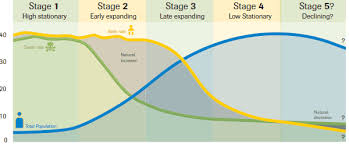IB ESS Unit 8
1/13
There's no tags or description
Looks like no tags are added yet.
Name | Mastery | Learn | Test | Matching | Spaced |
|---|
No study sessions yet.
14 Terms
Population data
Crude Birth Rate → number of live births per 1000 people per year
Crude Death Rate → number of deaths per 1000 people per year
Natural Increase Rate → growth or decrease of population
(CBR - CDR)
10
Total Fertility Rate → number of children a woman is expected to have in a lifetime
Replacement Rate → relates to replacement fertility because of infant and childhood mortality
Doubling Time → the length of time it takes for a population to double in size, assuming its natural growth rate is constant.
70 / % growth per unit time
Population Momentum → the tendency for population growth to continue after replacement-level fertility has been reached
Factors impacting CBR & TFR
Children for labour
Urbanisation
Cost of raising/educating children
Women education & employment
Infant mortality rate
Average age at marriage
Availability of pension
Availability of health care
Availability & reliability of birth control and other contraceptives
Religious beliefs
Malthusian vs Boserup’s theory
Malthusian → believes that population growth will continue to climb until a “point of crisis” where resources can no longer keep up with the demand
Boserup → believes that as population and resource demand grows, agricultural technology will develop and adapt to the population/demand change, so we never reach the “point of crisis”

Population pyramids
Analysis by sex, of the proportion of population at each age level

Demographic transition model

Economic production
the process of converting the natural world into a manufactured world
3 types of Natural Capital
Renewable Natural Capital → self producing and self maintaining living species & ecosystems. they may use solar energy directly or indirectly. (e.g. wood, produce, meat, etc.)
Replenishable Natural Capital → non-living & dependent on solar engine for renewal (e.g. groundwater and the ozone layer)
Non-renewable Natural Capital → any use requires liquidating part of the stock (e.g. fossil fuels, metals & minerals)
Value of natural capital
Ecological value → natural goods or services (e.g. waste assimilation, flood and erosion control)
Economic value → determined by market price of goods or services
Aesthetic value → spiritual/philosophical/recreational
Solid Domestic Waste + Types
a rubbish that has no value to the producer. amount produced varies based on lifestyle (MEDCs > LEDCs).
Types:
paper
glass
metal
plastics
organic waste
yard waste
wood
food waste
Linear vs Circular Economy
Linear Economy → A linear economy follows a "take, make, dispose" model, where resources are extracted, used to create products, and then discarded as waste.
Example: Single-use plastics, where plastic is made, used once, and thrown away.
Circular Economy → A circular economy focuses on reducing waste by reusing, recycling, and regenerating materials to keep resources in use for as long as possible.
Example: Recycling aluminum cans into new cans instead of mining new aluminum.
Ways to deal with SDW
Reduce – Minimize waste production by using fewer disposable products (e.g., reusable bags and containers).
Reuse – Extend the life of products by repurposing or donating them (e.g., using glass jars for storage).
Recycle – Convert waste materials into new products (e.g., recycling paper, plastic, and metals).
Composting – Turn organic waste (food scraps, garden waste) into nutrient-rich soil.
Incineration – Burn waste to generate energy, though it may cause air pollution.
Landfills – Dispose of waste in designated sites, ideally using sanitary landfills to reduce environmental harm.
Waste-to-Energy (WTE) – Convert waste into electricity or heat through processes like incineration or biogas production.
Government Policies – Implement regulations such as bans on plastic bags, incentives for recycling, or waste management programs.
Ways to deal with waste pollution
Reduce Waste Production – Encourage minimal packaging, reusable products, and responsible consumption.
Improve Recycling Programs – Increase access to recycling bins and educate people on proper sorting.
Promote Composting – Convert organic waste into compost instead of sending it to landfills.
Ban or Limit Single-Use Plastics – Enforce policies to reduce plastic waste (e.g., plastic bag bans).
Invest in Waste-to-Energy Technology – Use incineration or biogas production to generate energy from waste.
Improve Landfill Management – Use sanitary landfills with proper lining to prevent soil and water pollution.
Human carrying capacity
The human carrying capacity refers to the maximum number of people that the Earth or a specific area can sustain without exhausting resources or harming the environment. It depends on factors like food production, water supply, and technology.
Example: A city with limited freshwater may only support a certain population before shortages occur.
Factors impacting human carrying capacity
Resources – Availability of essential resources like food, water, and energy.
Technology – Advancements in technology, such as agricultural techniques, renewable energy, and waste management, that can increase the efficiency of resource use.
Infrastructure – The development of infrastructure (roads, buildings, sanitation) that supports human activity and well-being.
Health – Access to healthcare, disease control, and sanitation that affects survival rates and population growth.
Environmental Impact – The ability of ecosystems to regenerate and support human activity without being degraded (e.g., pollution levels, deforestation).
Social Systems – Policies, education, and societal behaviors (e.g., birth control, resource management) that can influence population growth and resource use.
Climate – Climate conditions that affect food production, water availability, and livability of regions.
Waste Management – The capacity to process and recycle waste without harming the environment or depleting resources.